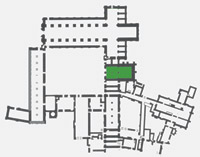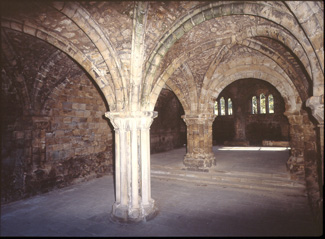|
|
You are here:
 The chapter-house
The chapter-house
 (1/2) (1/2) |
The chapter-house at Kirkstall, like those at
other abbeys, was situated in the eastern range, one of the most
inaccessible locations to outsiders. It was amongst the first buildings
erected and was completed before the end of the twelfth century;
in the thirteenth century the eastern half was rebuilt and brought
greater light to what may have previously been a rather dim room.
The monks gathered here every day for about an hour to attend the
chapter meeting, so called as a chapter from the Rule
of St Benedict was read aloud to the monks who sat on wooden
or stone benches around the walls. The abbot or his deputy who presided
occupied a pulpit in the eastern part of the room and there was
also a lectern here for the reader.
The chapter meeting opened with a reading of
the martyrology, to commemorate the saints celebrated that day,
and this was followed by a short morning prayer (the Pretiosa).
Thereafter a chapter from the Rule of St Benedict was read and this
marked the real start of the proceedings. On Sundays and feast days
a passage from either the Cistercian Customs (the Book of Usages)
or the Statutes of the General
Chapter was read and explained. An office to commemorate the
dead concluded the liturgical part of the meeting. Disciplinary
matters were then addressed. Each monk was invited to step forward
to confess his sins before the community. He prostrated himself
on the floor, asked pardon and awaited judgement. Those who were
not forthcoming were ‘accused’- out of charity - by their
brethren, so that they too could be judged and corrected, and progress,
unhindered, on the road to salvation.
| In 1206 the General Chapter of the Order
permitted that prisons might be built within the abbeys for
those who offended; in 1230 it was stipulated that these should
be strong and secure. Statutes from the General Chapter suggest
that from the second half of the thirteenth century life imprisonment
was not uncommon. |
Punishment usually consisted of fasting, demotion
or beating,(1) but in more extreme
circumstances, such as murder or sodomy, the offender might face
imprisonment or expulsion. Whilst the whole community witnessed
these punishments nobody was to disclose what had transpired at
chapter. After the necessary disciplinary measures had been taken
business matters were discussed – announcements were made,
letters read out, officials appointed and novices
or lay-brothers
professed. On certain feast days a sermon was given and on such
occasions the lay-brothers might join the monks in the chapter-house,
but if there was a shortage of space they were expected to listen
at the door.(2) At the close of
the chapter meeting the monks stood facing eastwards for the recitation
of Psalm 129 (De Profundis) and prayers.(3)
<back><next>
|







 (1/2)
(1/2)